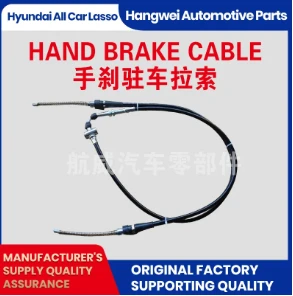throttle and throttle cable
Understanding Throttle and Throttle Cable Essential Components in Engine Performance
The throttle system plays a critical role in controlling the power output of an engine, whether it be in a car, motorcycle, boat, or any other motorized vehicle. At the heart of this system is the throttle and its corresponding throttle cable. Understanding these components can provide valuable insights into their functionality and importance in engine performance.
What is a Throttle?
The throttle is a valve that regulates the amount of air or fuel entering the engine. By controlling airflow, the throttle influences the engine's power output, thereby allowing the driver to manage the speed and acceleration of the vehicle. In modern vehicles, electronic throttle control (ETC) systems have largely replaced traditional mechanical throttles, providing faster and more precise adjustments. However, the basic principle remains the same the throttle opens and closes to control engine performance.
The Role of the Throttle Cable
The throttle cable is a critical component that connects the throttle pedal—where the driver applies pressure—to the throttle valve in the engine. When the driver presses the accelerator pedal, the throttle cable pulls on the throttle valve, prompting it to open and allowing more air to enter the engine. This, in turn, increases engine power and acceleration.
In traditional vehicles with mechanical throttle systems, the throttle cable is typically made of metal or durable plastic, designed to withstand tension and operate smoothly. The length and routing of the throttle cable are carefully engineered to minimize friction and ensure efficient movement. It’s essential that the cable remains free of obstructions and operates without any excessive wear to maintain optimal performance.
The Mechanics of Throttle Control
When the driver pushes down on the accelerator, the following series of actions occurs
throttle and throttle cable

1. Input Transmission The pedal movement is conveyed through the throttle cable. 2. Throttle Response The throttle cable pulls the throttle plate open. This allows more air to flow into the intake manifold. 3. Fuel Management The engine management system detects the increase in airflow and adjusts the fuel injection accordingly, ensuring the optimal air-fuel mixture for combustion. 4. Power Delivery The engine responds by producing more power, which translates into increased vehicle speed and acceleration.
In electronic throttle control systems, the process is largely similar, but instead of a cable mechanically linking the throttle pedal to the throttle valve, electronic sensors and motors are employed. This enhances responsiveness and allows for features like cruise control and traction control, wherein the engine can optimize throttle position based on various driving conditions.
Maintenance and Troubleshooting
Just like any mechanical system, the throttle and its cable require regular maintenance to ensure proper functionality. Common issues include
- Cable Fraying or Damage Over time, the throttle cable can wear out, fray, or even break, leading to a loss of throttle response. - Sticking or Binding Dirt, debris, or corrosion can cause the throttle to stick, making acceleration unpredictable and potentially dangerous. - Out-of-Adjustment Cable A throttle cable that is incorrectly adjusted can lead to excessive or insufficient throttle response, affecting driving dynamics.
Regular inspection and maintenance are vital. Ensuring that the throttle cable is properly lubricated and free from damage can prolong its lifespan and enhance driving safety. If issues are detected, consulting a professional mechanic is recommended to avoid further complications.
Conclusion
The throttle and throttle cable are integral components of any combustion engine-powered vehicle. They enable the driver to control speed and power effectively. Understanding how these systems function can help drivers appreciate the complexities of their vehicles and underscore the importance of regular maintenance. Whether in a high-performance car or a simple commuter, the efficient operation of the throttle system is key to ensuring optimal vehicle performance and safety on the road. Always remember, a well-maintained throttle system contributes significantly to a smooth and responsive driving experience.
-
Workings of Clutch Pipe and Hose SystemsNewsJun.04,2025
-
The Inner Workings of Hand Brake Cable SystemsNewsJun.04,2025
-
The Secrets of Throttle and Accelerator CablesNewsJun.04,2025
-
The Hidden Lifeline of Your Transmission Gear Shift CablesNewsJun.04,2025
-
Demystifying Gear Cables and Shift LinkagesNewsJun.04,2025
-
Decoding Clutch Line Systems A Comprehensive GuideNewsJun.04,2025
